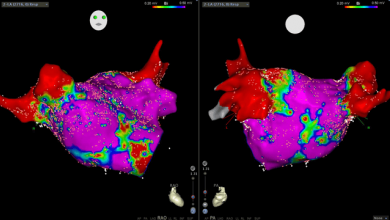Search results
Author(s):
Jean-Baptiste Gourraud
,
Jason G Andrade
,
Laurent Macle
,
et al
Added:
3 years ago
Atrial fibrillation (AF) is the most common sustained cardiac arrhythmia observed in clinical practice, occurring in approximately 2 % of the general population.1–3 A progressive increase in both the prevalence and incidence of AF has been demonstrated in recent years, defining AF as a major economic and public health issue.1
The identification of sites of AF initiation and/or maintenance within…
View more
Author(s):
George D Katritsis
,
Hugh Calkins
Added:
3 years ago
Over the past decades catheter ablation of atrial fibrillation (AF) has evolved from being a largely experimental procedure to a well-established therapeutic option for certain patients with AF.1–4 Currently the backbone of most catheter ablation techniques is to target the pulmonary veins (PVs) in order to achieve their electrical isolation and maintain sinus rhythm (SR).1 Additional techniques…
View more
Author(s):
Satoshi Higa
,
Li-Wei Lo
,
Shih-Ann Chen
Added:
3 years ago
Catheter ablation of AF has become an established therapy and may have the potential to cure this most commonly encountered sustained arrhythmia. Previous studies have demonstrated that pulmonary veins (PVs) are a major source of the ectopic beats that initiate AF. PV isolation in patients with symptomatic paroxysmal AF refractory to antiarrhythmic drugs is effective; however, it is difficult to…
View more
Author(s):
Rakesh Latchamsetty
,
Fred Morady
Added:
3 years ago
Catheter ablation of AF has shown steady growth over the past two decades with a nearly 15 % annual increase in the US.1 This growth can be attributed in large part to four factors: an increase in operators and institutions performing the procedure;2 a steady rise in AF prevalence, which is predicted to reach 12 million in the US by 2030;3 a larger spectrum of AF patients with more complex atrial…
View more
Author(s):
Jorge E Romero
,
Ricardo Avendano
,
Michael Grushko
,
et al
Added:
3 years ago
Oesophageal injury prevention has become a major concern in the field of electrophysiology since the first case of atrio–oesophageal fistula was reported as a complication of endocardial surgical radiofrequency ablation (RFA),1 with Scanavacca et al. and Pappone et al. subsequently reporting this complication in patients who underwent percutaneous pulmonary vein isolation (PVI) for AF.2,3 It is…
View more
ThermoCool® SmartTouch® Catheter
Author(s):
Tina Lin
,
Feifan Ouyang
,
Karl-Heinz Kuck
,
et al
Added:
3 years ago
Article
Author(s):
Alessio Galli
,
Francesco Ambrosini
,
Federico Lombardi
Added:
3 years ago
Since the 1960s, Holter monitoring has been a cornerstone for diagnosing suspected arrhythmias in patients of all ages.1 The most common monitoring systems allow the continuous registration of three or more leads for 24–48 hours; newer Holter monitors allow continuous electrocardiogram (ECG) registration for 2 weeks.1 Extending the time of ECG registration will increase the diagnostic yield of…
View more
Author(s):
Steven M Markowitz
,
George Thomas
,
Christopher F Liu
,
et al
Added:
3 years ago
Pioneering electrophysiology studies in the 1990s defined the anatomical boundaries of typical atrial flutter, identified regions for effective catheter ablation of this arrhythmia and described procedural endpoints to minimise recurrences after ablation. Activation and entrainment mapping demonstrated that typical flutter arises from reentry around the tricuspid annulus.1 Criteria to confirm…
View more
Author(s):
Amir A Schricker
,
Junaid Zaman
,
Sanjiv M Narayan
Added:
3 years ago
Catheter ablation is more effective than pharmacological therapy for the secondary prevention of patients with paroxysmal1,2 and persistent3,4 atrial fibrillation (AF) and has an emerging role in the primary prevention of paroxysmal AF.5,6 Nevertheless, in randomised clinical trials (RCTs) its success in treating patients with paroxysmal AF is 40–60% for a single procedure and 70% for multiple…
View more
Author(s):
Marius Andronache
,
Nikola Drca
,
Graziana Viola
Added:
4 years ago










 « First
« First